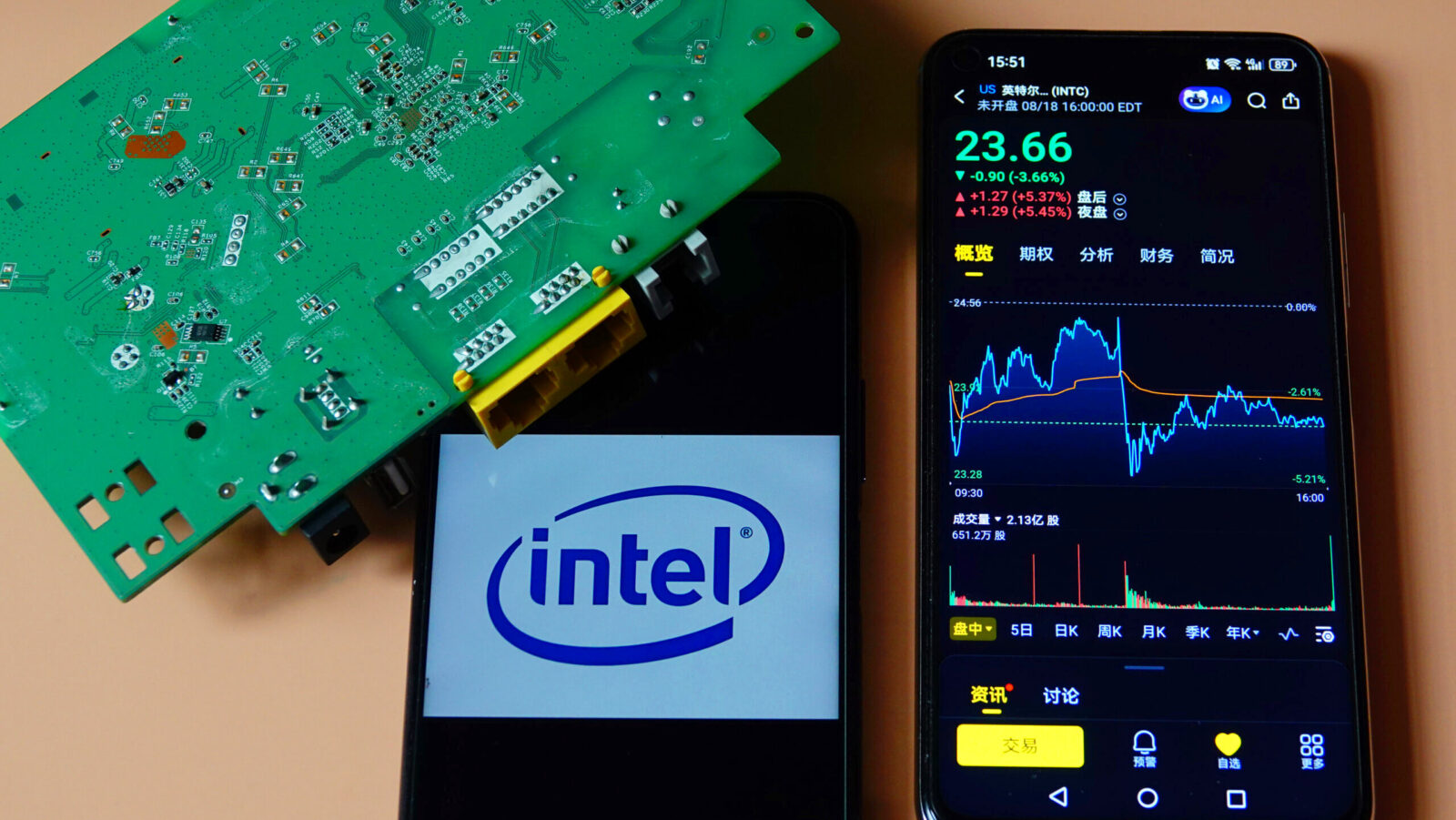Good morning.
S&P 500 CEOs saw their pay climb 7.7% last year, the fastest pace in four years, the consultant Farient Advisors told the Financial Times Tuesday. Not since 2021’s 11.5% gain has the median total compensation for top bosses been so high.
Starbucks holds the honors of having the widest pay gap between the top executive and median employee, according to the AFL-CIO, with CEO Brian Niccol’s nearly $96 million pay package coming in at 6,666 times greater than the median Starbucks employee, a part-time barista making $15,000 per year. Nvidia exists on the other side of the spectrum, with CEO Jensen Huang’s roughly $50 million total pay coming in at just 166 times greater than the company’s average employee, an engineer who makes around $300,000 annually. Here’s a gentle reminder to tip your baristas.
SoftBank Acquires a 2% Stake in Embattled Intel

Intel’s turnaround may just require something of a team effort.
On Tuesday, Japanese investment giant SoftBank announced it had taken a $2 billion stake in Intel, with plans to help supercharge the struggling chipmaker’s revival. The deal, which gives SoftBank control over roughly 2% of Intel’s outstanding shares, comes as the US government explores a deal to take as much as a 10% stake in the Santa Clara, California, firm.
Chip Stack
That’s a lot of a lot. Intel needs it all and maybe more. While it’s technically the only major designer and manufacturer of leading-edge chips in the US, the company has largely failed to convince tech players that its Gaudi AI Accelerator chips could serve as a viable alternative to Nvidia’s popular GPUs, while its expensive foundry business has completely failed to compete with industry titan TSMC. The company has reported a total net loss of around $3.7 billion through the first half of the year, after a staggering $18.8 billion net loss in fiscal 2024, and has openly flirted with exiting the foundry business if it fails to secure a major client soon.
Enter SoftBank. According to sources who spoke with the Financial Times, the two sides discussed several versions of a deal — including one in which SoftBank would have acquired Intel’s foundry business outright — but ultimately agreed on a $2 billion investment that gives Intel a major financial lifeline amid its search for clients and its capital-intensive push to catch up to TSMC’s manufacturing capacity. Crucially, it also places Intel into SoftBank’s growing AI ecosystem:
- SoftBank is already the majority owner of British chip designer Arm and is a leading investor in OpenAI, which is working to reduce its reliance on key supplier Nvidia. Last week, Reuters reported that current and former OpenAI employees were looking to sell up to $6 billion worth of shares to a SoftBank-led group of investors.
- SoftBank and OpenAI also have ambitious plans to expand AI infrastructure in the US, primarily through the $500 billion “Project Stargate” initiative the two firms announced earlier this year with Oracle.
Central Intel-igence: Of course, SoftBank isn’t the only player to notice that Intel is struggling. The company scored roughly $10.9 billion in grants and low-interest loans from the US government via the Biden-era Chips and Science Act, and now the Trump administration wants to get an equity stake in exchange for that. US Commerce Secretary Howard Lutnick made clear in an interview with CNBC on Tuesday that the White House isn’t seeking voting or governance rights in Intel, however. The idea comes after the president earlier this month publicly called for the resignation of new Intel CEO Lip-Bu Tan (who happens to be a former SoftBank board member) over alleged ties to the Chinese government. After a White House meeting with Tan this week, the president said Tan has an “amazing story” — one that, apparently, he prefers the US government to be a part of.
They Can’t Steal What They Can’t Find
An identity theft attempt happens every 22 seconds. Why? Because your personal information (address, phone number, email) are floating around the internet for anyone to grab.
In the wrong hands, those details can be used to open credit cards, take out loans, or create fake accounts in your name before you’ve finished your morning coffee.
Meet Incogni, the expert in digital cleanup, working behind the scenes to erase your data from places you can’t reach.
With Incogni’s Unlimited Plan, if there’s a link exposing your personal data — like those eerie search results where every detail is neatly itemized behind a paywall — just send it over. They’ll make it vanish.
Protect your privacy before someone else profits from it.
Brokers Chafe Under Abrupt Expansion of Steel, Aluminum Tariffs
Most people spent the past weekend enjoying one of their final summer respites before the school year kicks off and vacation season winds down: with their feet up reading a book on the porch, swimming at the lakehouse, taking a breezy hike or relishing drinks on a patio at dusk.
Those in the logistics industry are not most people: Their weekend consisted of scrambling like a dozen Mondays had been squeezed into a 48-hour vortex by a tear in the space-time continuum originating in Washington, D.C. That’s because the Trump administration blindsided customs brokers and importers by quickly and quietly expanding steel and aluminum tariffs to over 400 items that contain the metals.
Irritation and Inflation
President Donald Trump initially placed 25% tariffs on aluminum and steel imports in March via executive order, before hiking the rate to 50%, which far outstrips the general tariff rate his administration has placed on imports from most countries. In most cases, markets and supply chains have gotten at least a small grace period or heads-up with new or expanded levies — four days when the aluminum and steel tariffs were doubled on May 31, for example.
In this case, the courtesy lasted the weekend: On Friday, US Customs sent out a bulletin about the changes, which only appeared in the Federal Register on Tuesday. “The brokerage community (well, at least the ones I know) spent all weekend trying to clear goods subject to the tariff in time, get a hold of clients who may not realize it’s happening and being very, very irritated,” wrote Pete Mento, the head of global customs at logistics giant DSV. If you’re wondering what’s got them so busy:
- The new tariffs cover products from wind turbines to mobile cranes, bulldozers, railcars and even chemicals that come in aluminum or steel vessels. “Basically, if it’s shiny, metallic, or remotely related to steel or aluminum, it’s probably on the list,” wrote Brian Baldwin, vice president of customs at Kuehne + Nagel.
- Jason Miller, a professor of supply chain management at Michigan State University’s business school, calculated that the new tariffs impact “well over $130 billion of imports based on 2024 data (and that is above and beyond the roughly $190 billion of goods already subject to these §232 tariffs).” He cautioned: “This will add more inflationary cost-push pressures to already climbing prices that domestic producers are charging.”
Highly Rated: Not everyone is so down on tariffs. S&P Global said Monday that it expects Trump’s tariffs will produce “meaningful” government revenue that could “generally offset weaker” revenue resulting from the GOP’s recently enacted “big beautiful bill” that will cut taxes and increase government spending. The ratings agency on Monday cited the windfall of revenue from tariffs as a reason for maintaining its AA+ rating on US sovereign debt.

They’re Calling It The ‘Freedom Dividend.’ Elon Musk calls for Universal Income as AI threatens to eliminate jobs. But who will pay for it? Instead of relying on taxpayer funding, Mode Mobile turns attention into currency, already paying out $325M to +50M users. Invest at $0.30/share before the window closes.*
Home Depot Predicts Pent-Up Home Improvement Demand
At a certain point, just watching Home Improvement reruns on Hulu or Netflix isn’t enough; sooner or later, homeowners will need to channel their inner Tim Allen and take on long-delayed home improvement plans. Home Depot is betting sooner.
The big box retail giant is sticking by its full-year guidance, executives said during its second-quarter earnings call on Tuesday, even after the company missed analysts’ sales estimates for the second straight time. Still, Wall Street noted the optimism from a firm that serves as something of a bellwether for both the American consumer and the American housing market.
It’s the Small Things
Sales at stores open at least a year increased 1% in Home Depot’s second quarter, below expectations but marking just the second time in eight quarters that the company reported growth at all. In the same quarter a year ago, Home Depot reported a sales decrease of 3.3%. And while the company has recently made significant moves to reorient its business around a professional clientele, it was the amateurs, accounting for roughly 45% of Home Depot’s business, who helped fuel its return to growth. In an interview following the company’s earnings report, CFO Richard McPhail said that do-it-yourself customers have been pushing forward with smaller home improvement projects — such as new lighting or garden upgrades — as they postpone larger projects that require financing.
Still, Home Depot says big home improvement projects are coming soon, one way or another:
- “Our customers are telling us they are putting projects on hold, they are not cancelling them,” McPhail added. CEO Ted Decker said that “some relief on mortgage rates, in particular, could help” spur demand for larger-scale home improvement projects.
- And while the market has largely kept new buyers out, existing home owners have seen a massive increase in home equity since 2019, which they can tap to finance home improvement projects. In fact, the Federal Reserve Bank of New York’s second-quarter household debt report found that home equity lines of credit had increased for the 13th consecutive quarter.
Tariff Time: Awaiting DIY customers whenever they do get around to big projects? “Modest price movement” [read: increases] “for some categories,” McPhail said. That comes after Home Depot said earlier this year that it would keep prices steady despite rising tariffs, though it comes as little surprise, too. A Goldman Sachs report earlier this month suggested US consumers have just started to bear the brunt of tariff costs, with much more likely to be passed down as the year goes on.
Extra Upside
- Access Denied: Under pressure from the US, the United Kingdom dropped demands that Apple provide its government access to secure, encrypted user data.
- Station Consolidation: Nexstar, America’s largest owner of TV stations, said it plans to acquire rival Tegna for $6.2 billion, including debt, in a local TV mega-merger. Another rival, Sinclair, has proposed its own merger with Tegna.
- Crash Course: 95% of generative AI pilot programs at companies are delivering little to no measurable impact on a business’s bottom line, a new study from researchers at MIT found.
Just For Fun
Disclaimer
*Please read the offering circular at invest.modemobile.com. This is a paid advertisement for Mode Mobile’s Regulation A Offering. A reservation of the ticker symbol is not a guarantee that we will be listed on the NASDAQ. Any IPO timing is unknown, general steps to be accepted have not been undertaken at this point, and that listing is not guaranteed.
Share price set by the company.
Editor’s Note: Our Sunday story incorrectly said a user-growth miss at Reddit “prompted a wave of ‘sell’ ratings from Wall Street analysts.” Analysts at Redburn-Atlantic initiated coverage with a sell rating after the miss, while Bernstein reiterated its sell rating and Wells Fargo downgraded the stock. We regret the error.

